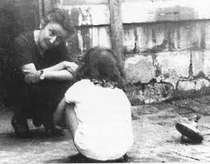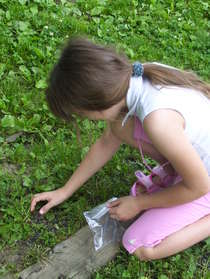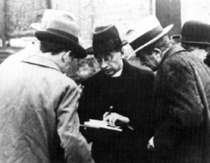 Caryll Houselander Last week I was feeling particularly discouraged. Selling intimate apparel was never my dream job! As I spoke with customers and cleaned out fitting rooms that had been left a mess, I wondered what a person with a graduate degree, an educator, and author was doing in my position. The Holiday shopping season looming ahead did littel to brighten my mood.
Caryll Houselander Last week I was feeling particularly discouraged. Selling intimate apparel was never my dream job! As I spoke with customers and cleaned out fitting rooms that had been left a mess, I wondered what a person with a graduate degree, an educator, and author was doing in my position. The Holiday shopping season looming ahead did littel to brighten my mood.
I guess I had forgotten the lessons learned from Brother Lawrence about “Practicing the Presence of God.” Reading through some of the reflections in Liturgical Press’s new monthly prayer guide, “Give Us This Day,” reminded me of the call to be present to God in the ordinary events of our lives.
The October “Blessed Among Us” reflection highlighted a woman I have read, Caryll Houselander, an English laywoman mystic whose vocation was to help others become aware of Christ in our world. She was not the stereotypical mystic. She enjoyed a drinking, battled for twenty years to give up chain-smoking, and was left broken hearted by the man she loved. She never married.
Her mystical visions were of Christ in those around her. In one, she saw him suffering in a Bavarian nun, who being German, suffered discrimination during WWII in England. In another, she saw Christ in each person in a busy railway station. In some he was rejoicing, happy, in others, suffering and in pain. Her first book. This War Is the Passion,”was written in 1941 and presented the sufferings of those traumatized by WWII through the perspective of the passion of Christ.
She was an artist, a wood carver, but later in her life, writing became her primary artistic expression.She wrote numerous books, articles, poems, and articles for children. For all that, she saw her primary vocation expressed through interactions with others, particularly those on the fringes of society, those no one else wanted to be with.
She had a gift of helping children scarred by the war and though she had no training, often was sought out to counsel them. She gave her time and heart to the mentally ill, the poor, the distraught. Through all, she saw Christ in every one. Caryll Houselander died of breast cancer in 1954.
 Another woman who was highlighted in the October issue of “Give Us This Day” was someone I had not heard of before: Madeleine Delbrel. She was a Frenchwoman, daughter of a railroad worker. After considering becoming a nun, she decided her call was to be with ordinary people in the world. The reflection includes this quote: “We, the ordinary people of the streets, believe that this street, this world, where God has placed us, is our place of holiness.”
Another woman who was highlighted in the October issue of “Give Us This Day” was someone I had not heard of before: Madeleine Delbrel. She was a Frenchwoman, daughter of a railroad worker. After considering becoming a nun, she decided her call was to be with ordinary people in the world. The reflection includes this quote: “We, the ordinary people of the streets, believe that this street, this world, where God has placed us, is our place of holiness.”
I read and thought she probably would include the department store where I work in her “place of holiness.” Like Caryll Houselander, Madeleine was aware of God’s presence in those she met. Ordinary acts like answering a phone or, I suppose, selling a bra, can be a way of sharing God’s love and friendship with others. No need for a church or ritual, her work was reaching out to others wherever she was.
Along with some friends, she established a small community near Paris. As I read this, I recognized my own need for a community with whom to share my work, my struggle, my prayer. Together they served the working poor.
Like Brother Lawrence, she developed a simple spirituality of becoming aware of the presence of God in the most ordinary experiences. She called her spirituality the “Prayer of the Agenda.”
I have written a book of reflections on my efforts to see the Sacred in our midst, “All Earth Is Crammed With Heaven,” but I need reminded. We all do.
We need reminded that we need not travel far, accomplish feats that gain us fame, or even hold a well paying job. We need to share Christ’s love and compassion with all we meet. We need to see God in the poor and outcast, the abused women and hungry children, the victims of war and terrorism. We need to be Christ for others. God’s work is done in the world and one the street; in the home and classrooms; in the office, and sometimes, in department stores.

 PHOTO: Mary van Balen When my daughter briefly entered graduate school in science and math education, she did a short stint in an affluent suburban high school physics class. Besides being disappointed in the interest and knowledge base of the students, she was surprised by the software being used. Instead of actually building small “contraptions” to test various energy sources (springs, levers, weights, etc) the students manipulated models on a computer program.
PHOTO: Mary van Balen When my daughter briefly entered graduate school in science and math education, she did a short stint in an affluent suburban high school physics class. Besides being disappointed in the interest and knowledge base of the students, she was surprised by the software being used. Instead of actually building small “contraptions” to test various energy sources (springs, levers, weights, etc) the students manipulated models on a computer program. Wasting time” mixing concoctions of baking soda, vinegar, and cabbage juice can whet the appetite for chemistry. Keeping a microscope in a kitchen cupboard, making place for a chemistry set in the basement, having art supplies easily accessible, taking long walks and picking up bugs and plants…all these things are, at some stages, more important than playing computer games or learning math online.
Wasting time” mixing concoctions of baking soda, vinegar, and cabbage juice can whet the appetite for chemistry. Keeping a microscope in a kitchen cupboard, making place for a chemistry set in the basement, having art supplies easily accessible, taking long walks and picking up bugs and plants…all these things are, at some stages, more important than playing computer games or learning math online. PHOTO: Mary van Balen Almost two months have passed since my last blog. The reasons are many. The most important is the passing of my father, Joseph Van Balen. My siblings and I have shared Dad’s care for about two years. Despite evenings when I wanted to drive home after a long day at work rather than drive to have dinner and a walk with Dad, I was always richer for having spent time with him. I hope the hours we spent together were as much a blessing for him as they were for me.
PHOTO: Mary van Balen Almost two months have passed since my last blog. The reasons are many. The most important is the passing of my father, Joseph Van Balen. My siblings and I have shared Dad’s care for about two years. Despite evenings when I wanted to drive home after a long day at work rather than drive to have dinner and a walk with Dad, I was always richer for having spent time with him. I hope the hours we spent together were as much a blessing for him as they were for me. While cleaning my parents’ home, I came across a framed print of the Sacred Heart of Jesus that hung in their bedroom. Devotion to the Sacred Heart was not big in our home. I think someone gave the picture to my mother, a convert, when she entered the Catholic Church. Jesus always looked a little wimpy to me, and I couldn’t get into the “heart on his chest” image. I donated the print to a local Saint Vincent de Paul shop figuring someone who frequented the store might want it.
While cleaning my parents’ home, I came across a framed print of the Sacred Heart of Jesus that hung in their bedroom. Devotion to the Sacred Heart was not big in our home. I think someone gave the picture to my mother, a convert, when she entered the Catholic Church. Jesus always looked a little wimpy to me, and I couldn’t get into the “heart on his chest” image. I donated the print to a local Saint Vincent de Paul shop figuring someone who frequented the store might want it. PHOTO: Mary van Balen “I am SO glad this is August 2 and the mess in Washington, for better or worse, is finally over.”
PHOTO: Mary van Balen “I am SO glad this is August 2 and the mess in Washington, for better or worse, is finally over.” News stations have a countdown clock ticking off minutes as the deadline to raise the United States debt ceiling approaches. Tuesday is the day, and many Americans are watching to see what will happen. Will the US default on its debts? Will our representatives and senators be able to transcend their philosophical differences and compromise?
News stations have a countdown clock ticking off minutes as the deadline to raise the United States debt ceiling approaches. Tuesday is the day, and many Americans are watching to see what will happen. Will the US default on its debts? Will our representatives and senators be able to transcend their philosophical differences and compromise?  Portrait by Berthold Pluum He was listed under “Other Saints” on the
Portrait by Berthold Pluum He was listed under “Other Saints” on the  Not many years after returning home, Titus along with the rest of the Dutch people began suffering under the invasion of the Nazis. In both his writing and preaching, Titus refused to follow their directives. When the Dutch Church decided to instruct the editors of all its newspapers and magazines to refuse to publish Nazi articles and propaganda, Titus insisted on informing each editor and staff himself.
Not many years after returning home, Titus along with the rest of the Dutch people began suffering under the invasion of the Nazis. In both his writing and preaching, Titus refused to follow their directives. When the Dutch Church decided to instruct the editors of all its newspapers and magazines to refuse to publish Nazi articles and propaganda, Titus insisted on informing each editor and staff himself.  This blog is named after the symbol for pilgrimage that had its beginnings with the great pilgrimage to the cathedral of Santiago de Compestela in Galicia in Northwest Spain: The scallop shell. The connection of this shell with pilgrimage is rooted in both use and legend.
This blog is named after the symbol for pilgrimage that had its beginnings with the great pilgrimage to the cathedral of Santiago de Compestela in Galicia in Northwest Spain: The scallop shell. The connection of this shell with pilgrimage is rooted in both use and legend. 
 I arrived at the airport in plenty of time. My flight was delayed, enabling me to grab a quick breakfast. While waiting for the food to arrive, I decided to check out my cell phone. It had to be SOMEWHERE in my black carry on, I told myself as I rummaged through it. No luck.
I arrived at the airport in plenty of time. My flight was delayed, enabling me to grab a quick breakfast. While waiting for the food to arrive, I decided to check out my cell phone. It had to be SOMEWHERE in my black carry on, I told myself as I rummaged through it. No luck.